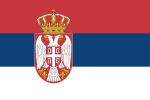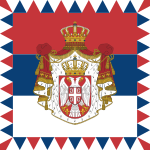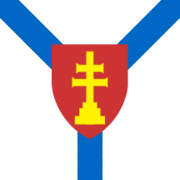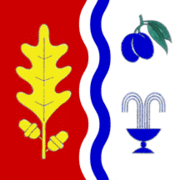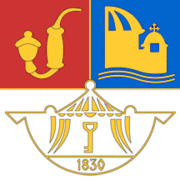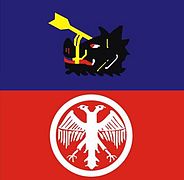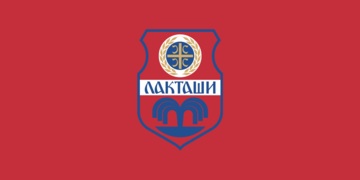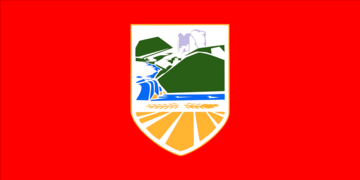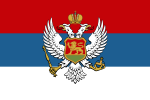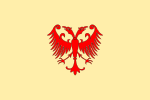
The Serbian Empire was a medieval Serbian state that emerged from the Kingdom of Serbia. It was established in 1346 by Dušan the Mighty, who significantly expanded the state.

Stefan Vladislav was the King of Serbia from 1234 to 1243. He was the middle son of Stefan the First-Crowned of the Nemanjić dynasty, who ruled Serbia from 1196 to 1228. Radoslav, the eldest son of Stefan the First-Crowned, was ousted by the Serbian nobility due to increasing Epirote influence through his marriage alliance to Theodore Komnenos Doukas; thus Vladislav became his successor. He is celebrated as Saint Vladislav by the Serbian Orthodox Church.

The flag of Serbia, also known as the Tricolour, is a tricolour consisting of three equal horizontal bands, red on the top, blue in the middle, and white on the bottom, with the lesser coat of arms left of center. The same tricolour, in altering variations, has been used since the 19th century as the flag of the state of Serbia and the Serb people. The current form of the flag was adopted in 2004 and slightly redesigned in 2010.

Fudbalski klub Borac Banja Luka is a Bosnian professional association football club, based in the city of Banja Luka, Bosnia and Herzegovina, and is the major part of the Borac Banja Luka Sports Society. Borac Banja Luka is one of the most popular football clubs in Bosnia and Herzegovina. The name Borac means "Fighter".

The coat of arms of the Republic of Serbia consists of two main heraldic symbols which represent the identity of the Serbian state and Serbian people across the centuries: the Serbian eagle and the Serbian cross. The coat of arms also features the Serbian historical crown; while unusual for republics, it is not unprecedented, as can be seen in coat of arms of numerous European countries with republican form of government.

The Serbian cross, also known as the Firesteels, is one of national symbols of Serbia. It is present on the coat of arms and flag of Serbia. The cross is based on a tetragrammic cross emblem of the Palaiologos dynasty of the Byzantine Empire, with the difference in Serbian use being that the cross is usually white on a red background, rather than gold on a red background.

Vladimir Ćorović was a Serb historian, university professor, author, and academic. His bibliography consists of more than 1000 works. Several of his books on the history of Serb, Yugoslav, Bosnian and Herzegovinian uprisings are considered to be definitive works on the subject.
Miodrag B. Protić was a Serbian painter, art critic, theorist and historian of art of the 20th century.
Matija Vuković was a Serbian sculptor.

The Uprising in Banat was a rebellion organized and led by Serbian Orthodox bishop Teodor of Vršac and Sava Temišvarac against the Ottomans in the Eyalet of Temeşvar. The uprising broke out in 1594, in the initial stage of the Long Turkish War, and was fought by local Serbs, numbering some 5,000, who managed to quickly take over several towns in the region before being crushed by the Ottoman army. The relics of Saint Sava were burnt by the Ottomans as a retaliation. Although short-lived, it inspired future rebellions.

The Serbian eagle is a double-headed heraldic eagle, also known as the White eagle, a common symbol in the history of Serbian heraldry and vexillology. The double-headed eagle and the Serbian cross are the main heraldic symbols which represent the national identity of the Serbian people across the centuries, originating from the medieval Nemanjić dynasty. The eagle, defaced with the cross, has been used in the coat of arms of the Kingdom of Serbia from 1882 to 1918 and in contemporary coat of arms of the Republic of Serbia since 2004.

The siege of Belgrade was a successful attempt by Imperial Habsburg troops under the command of the Elector of Bavaria Maximilian II Emanuel to capture the city of Belgrade from the Ottoman Empire. Part of the Great Turkish War (1683–1699), the siege lasted a month and culminated in the capture of the city on 6 September 1688. By conquering Belgrade, the Imperialists gained an important strategic outpost, as the city had been the Ottoman's chief fortress in Europe for more than a century and a half. The Turks recaptured it two years later, only to lose it again to Eugene of Savoy in 1717.

Serbian heraldry involves the study and use of coats of arms and other heraldic insignia in the country of Serbia or by Serbs. The Serbian government is the armiger in Serbia, exercising that right under the advice of the Serbian Heraldry Society, a learned society devoted to the study and creation of heraldry, specifically Serbian heraldry.

Ženski košarkaški klub Partizan, commonly referred to as ŽKK Partizan or simply Partizan, is a women's professional basketball club based in Belgrade, Serbia. Since 2015, the club has been competing under the legal name Partizan 1953. It is part of the multi-sports club Partizan. They are currently competing in the Serbian First League. The club won seven national championships, five national cups and two Adriatic League. They play their home games at the Sports Hall "Ranko Žeravica".
Avram Miletić was a merchant and writer of epic folk songs who is best known for writing the earliest collection of urban lyric poetry in Serbian between 1778 and 1781.
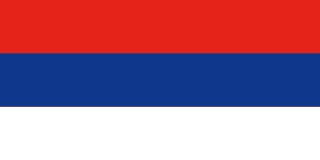
The flag of the Serbs of Croatia is the official symbol of the Serb national minority in Croatia. It was introduced into official use throughout the country on 9 April 2005 based on the decision of the Serb National Council, an elected political, consulting and coordinating body which acts as a form of self-government and autonomous cultural institution of the Serbs of Croatia. The council received consent of the Council for National Minorities of the Republic of Croatia before the decision. At the time of the statewide introduction, the flag was already officially used in Eastern Slavonia since the 14 November 1997 decision of the Joint Council of Municipalities made at the final stage of the UNTAES deployment in the region.
Radovan Samardžić was a Yugoslav and Serbian historian, member of the Serbian Academy of Sciences and Arts (SANU).
The krstaš-barjak refers to various war flags with crosses in the centre, part of Montenegrin tradition, originating from medieval military flags. The krstaš-barjak is known that Serbian Emperor Stefan Dušan adopted the Byzantine cross flag. According to Serbian epic poetry, during the Ottoman period, hajduks had war flags with crosses (krstaš-barjak) or icons of saints. The krstaš-barjak is mentioned in poems of the Kosovo Cycle; knight Boško Jugović bears it at the battle of Kosovo (1389). It was used as the general rebel flag during the Serbian Revolution (1804–17), and as the secondary flag of the supreme commander. It was later adopted as a military flag by the Principality of Montenegro (1852–1910) and Kingdom of Montenegro (1910–1918). The Montenegrin war flag used in the Battle of Vučji Do (1876) was red with a white cross pattée in the center and a white border, and tradition holds that it was adopted from the war flag of Kosovo which found itself in Montenegro after surviving knights brought it there. In Peroj, it is held that their ancestors had a war flag used at Kosovo in their possession.
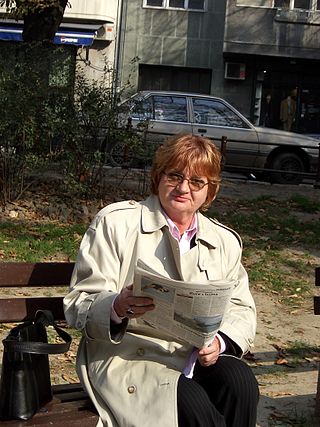
Mirjana Stefanović was a Serbian writer.
